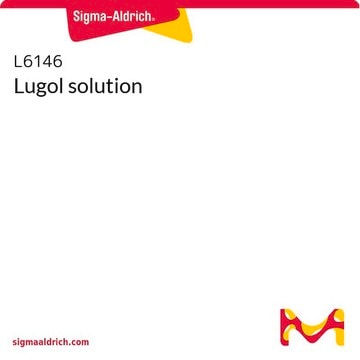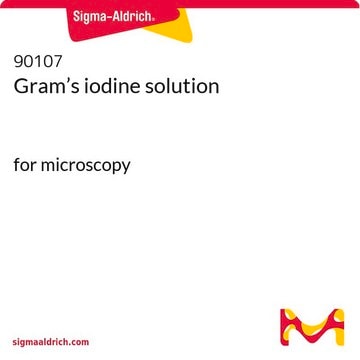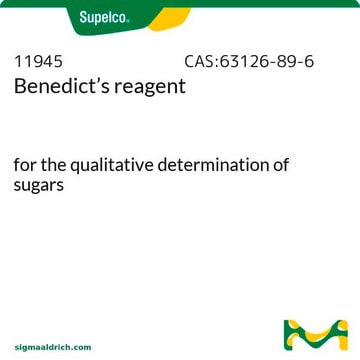This product is not suitable for preserving or fixing phytoplankton. No strong iodine solutions are offered for sale due to regulatory issues. Only weak solutions of iodine are available, generally containing about 1% combined iodine and potassium iodide. Strong solutions suitable for parasitology or for use in preserving phytoplankton are not available.
32922
Lugol solution
according to Lugol
Synonyme(s) :
Iodine/Potassium iodide solution
Sélectionner une taille de conditionnement
Sélectionner une taille de conditionnement
About This Item
Produits recommandés
Forme
liquid
Niveau de qualité
Qualité
according to Lugol
Densité
1.006 g/cm3 at 20 °C
Application(s)
diagnostic assay manufacturing
food and beverages
hematology
histology
Température de stockage
room temp
Chaîne SMILES
[K+].[I-].II
InChI
1S/I2.HI.K/c1-2;;/h;1H;/q;;+1/p-1
Clé InChI
XUEKKCJEQVGHQZ-UHFFFAOYSA-M
Vous recherchez des produits similaires ? Visite Guide de comparaison des produits
Catégories apparentées
Description générale
Application
- Lugol′s solution is generally used as a mordant in Gram staining, and for fixing invertebrate blood cells and protozoa.[1]
- It is suitable for the detection of starch in plants.
- It has been used in a study to assess narrow-band imaging without image magnification for detecting high-grade dysplasia and intramucosal esophageal squamous cell carcinoma.
- It has been used in a study to determine its benefit in aiding the detection, presence, and spread of small squamous cell carcinomas of the esophagus.
Actions biochimiques/physiologiques
Caractéristiques et avantages
- Ready-to-use solution.
Principe
Code de la classe de stockage
10 - Combustible liquids
Classe de danger pour l'eau (WGK)
WGK 2
Point d'éclair (°F)
Not applicable
Point d'éclair (°C)
Not applicable
Équipement de protection individuelle
Eyeshields, Gloves, multi-purpose combination respirator cartridge (US)
Faites votre choix parmi les versions les plus récentes :
Déjà en possession de ce produit ?
Retrouvez la documentation relative aux produits que vous avez récemment achetés dans la Bibliothèque de documents.
Les clients ont également consulté
-
Which Lugol`s solution for phytoplankton preservation sample used?
1 answer-
Helpful?
-
-
Buenas tardes. Por favor, pueden especificar las concentraciones de I2 y KI en las siguientes soluciones de Lugol (32922, 62650, y L6146)? No encuentro la información en su página web. Gracias
1 answer-
The composition of product 32922 is considered proprietary. The exact percentages of I2 and KI cannot be stated. The SDS for 32922 does state the composition for the Iodine is between 0.1% to less than 1%. This would suggest the composition of 32922 is comparable other standard "weak Lugol" formulations. Products L6146 and 62650 can be classified as "weak Lugol" formulations. Product L6146 and 62650 are formulated to contain approximately 0.35% Iodine and 0.70% Potassium Iodide. While the concentration of L6146 is a bit higher at 0.37% Iodine and 0.74% Potassium Iodide, there is no functional difference between these two products.
There are "strong" Lugol formulations that can approach a combined I2 and KI concentration of between 10 to 15%. These "strong" formulations are intended for use in procedures for parasitology. 32922, 62650 and L6146 are not suitable for use in procedures for parasitology.
Helpful?
-
-
What are the differences between Lugol solution, products 32922 & 62650?
1 answer-
The composition of product 32922 is provided in the Certificate of Analysis, while for product 62650, only the density is reported. The formulations of the two products appear to be the same, but there is a difference in the amount of quality control testing performed and reported. Both products are intended for Research Use Only and should be viewed as "weak" Lugol Iodine solutions.
Helpful?
-
Active Filters
Notre équipe de scientifiques dispose d'une expérience dans tous les secteurs de la recherche, notamment en sciences de la vie, science des matériaux, synthèse chimique, chromatographie, analyse et dans de nombreux autres domaines..
Contacter notre Service technique










